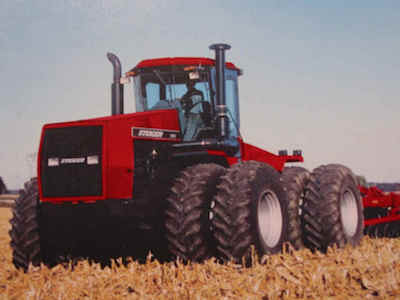Our past president, Duncan Allison, continues his series of enlightening articles on a variety of current ag topics. Enjoy!
FARMING NOTES – OCTOBER 2015
Science, Scale, Mechanization and New Technology – Agriculture has changed almost beyond belief from the subsistence situation that existed during the first half of the 19th century. By 1900 farmers still represented 38% of the population whereas today they represent 0.7%. One farmer fed 19 people in 1940 whereas today a farmer feeds 155 people. There was almost complete reliance on animal power. Today tractors are typically 150-250 hp but are commonly 300-350 hp on larger farms and the largest tractors are 620 hp. Seed drills used to be 4 and 6 rows but now seed 12, 24 or 36 rows. Farm size averaged 147 acres and it is now 434 acres. We had 25 million dairy cows in 1944 and today we have 9.25 million dairy cows producing infinitely more milk. Corn yields have increased from 20 bushels in 1900 to 38 in 1952 and are now over 160 bushels per acre.
The application of science has been the cause of this amazing increase in production – plant/livestock breeding, nutrition, cow comfort, pest and weed control etc. Mechanization has allowed much larger areas to be tilled, drilled, sprayed and harvested.
Farms whether dairy, corn, vegetables or fruit have also been able to take advantage of scale. This is not different from other industries. Statistics clearly show that well run large dairy farms are able to produce milk more cheaply than small farms. Scale in terms of production and a sophisticated marketing framework have enabled California to take advantage of their climate to produce one third of the country’s vegetables and two thirds of the fruit and nuts. Slim margins on most field crops favor large scale. USDA ERS economists recently (2013) concluded that “the shifts have been complex but land and production has been shifting primarily from mid-size commercial farming operations to larger farms while the count of very small farms has been increasing. Larger crop farms still realize better financial returns, on average, and they are better able to make more intensive use of their labor and capital resources, indicating that these trends are likely to continue.”
New innovation – Monsanto’s Fraley, Chief Technology Officer of Monsanto and World Food Prize Laureate, is confident that despite the challenges facing the world in providing enough food for the 9+ billion people in 2050 “there is an absolute tidal wave of new innovation coming into agriculture” he said earlier this year. “Innovation from biology, data science and information technology is converging across all aspects of agriculture.” “Breeding has changed more in the last five years than it has in the last 5,000.” Biotech crops were approved in 37 countries and planted by over 18 million farmers in 27 countries in 2013. According to Fraley, this technology has increased yields by 20 percent, reduced pesticide use by 30 percent and increased farmer productivity, which is why 95 percent of the corn and soybean producers in this country have utilized it.
As members of the broad farming community we can be proud that our industry has become a highly sophisticated and technical business and has been taking advantage of the latest scientific developments in a wide range of scientific disciplines. Sometimes the developments have been too fast for the general public to understand and accept like GMOs. It is also true that consumer concerns have had to be reflected in greater focus on the more humane treatment of livestock. Companies serving farmers have become much bigger and international so that they have the scale to carry out research and development to produce world class products whether mechanical, chemical, genetic or other. Our food supply will be increasingly influenced by the consumer and this is reflected in why so many major food corporations are pushing for sustainability from farm to fork. Sustainability continues to be a vital goal for our farms so that our 96% family farms can be passed on to the next generation while preserving the soil, water and natural environment.
The agriculture market now includes many large international companies that provide critical farm inputs such as the global seeds market which was estimated to be $23.65 billion in 2014 and increase to $55.3 billion at a CAGR of 11.2% by 2022. Crop protection chemicals are around $55 billion globally and forecast to grow to $70 billion by 2019 by one forecaster. Farm machinery was around $56 billion in 2010 and must also increase around the world as farms become larger and will need increasingly sophisticated equipment. Precision technology is another wide open field that is attracting the biggest companies. There is also greater interest by students in careers in agriculture since there are so many opportunities available requiring a wide range different skills and educational backgrounds.
Small farms and local food– 75% of our national 2.1 million farms sell less than $50,000 of farm products a year and supplying less than 3% of the total value of farm products sold. Most of these are part-time farmers. The 2012 Ag Census found that 144,530 farm operators sell direct to consumers through farmers markets, CSAs, farm stands etc. Locally produced food has now reached $12 billion and this figure is likely to increase as the demand for fresh local food continues to grow. This trend offers big opportunities for the small farms surrounding large urban areas such as Philadelphia. The success of the Oxford Produce Auction in western Chester County provides solid proof that local farmers, particularly the Amish, can readily increase their vegetable and flower production if a convenient bulk market is available locally. Farmers markets are demanding for producers who must spend time away from their farms with the challenge of utilizing fresh produce that is not sold. Pick your own fruit farms are further examples of local fruit farmers taking advantage of the local food interest. DAA 10/07/2015

